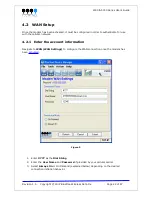
Section 7: Serial-IP
This feature allows communication over the cellular network in two common setups. The first
is a server communicating with a remote serial-only device and the other, a serial-only device
communicating with another remote serial-only device. Serial IP is used to emulate a direct
serial connection to the attached device, or to emulate a landline modem. The modem then
becomes a transparent middleman between the poller and the pollee. Serial IP is most
commonly used in telemetry applications such as meter reading and SCADA devices.
Figure 18
When the modem is in Serial IP mode, IP packets intended for the attached serial device have
their IP headers stripped before being passed on to the device. This means that the serial
device receives raw serial data that it can understand. Inversely, when the serial device is
sending data, the modem encapsulates this data in IP packets to be transmitted over-the-air
to the remote destination.
When a Serial IP server is running, the modem waits until a connection is made on the defined
Serial IP port, then triggers Serial IP mode. The incoming data will be relayed to the attached
serial device. Any output from the serial device will be sent to the IP of the remote computer
that made the connection on the port that the remote computer used to make the connection.
When using Serial IP, the modem configuration depends on the application requirements. The
four different scenarios are documented in a Support Note (#SN0703121) available at:
http://www.bluetreewireless.com/support/downloads/documents/details.asp?id=69
















































